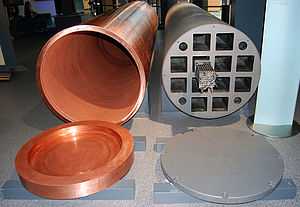KBS-3

KBS-3 (an abbreviation of kärnbränslesäkerhet, nuclear fuel safety) is a technology for disposal of high-level radioactive waste developed in Sweden by Svensk Kärnbränslehantering AB (SKB) by appointment from Statens Strålskyddsinstitut (the government's radiation protection agency). The technology was developed by studying different natural storage facilities such as the natural reactor in Oklo, Gabon, and the uranium mine in Cigar Lake, Canada. KBS-3 is also to be used in Finland at the Onkalo spent nuclear fuel repository, being built by Posiva.
General
The disposal method consists of the following steps:[1]
- The waste is first stored in intermediate storage for 30 years.
- The waste is encapsulated in cast iron canisters.
- The cast iron canisters are encapsulated in copper (CuOFP alloy) capsules.
- The capsules are deposited in a layer of bentonite clay, in a circular hole, eight meters deep and with a diameter of two meters, drilled in a cave 500 metres down into crystalline rock.
- After the storage facility is full, the drill hole is sealed and the site marked.
- After 100,000 years of storage, the radioactivity level of the waste is at the same level as that of uranium ore mined to make the fuel.[2]
If the holes into the rock from the cave are drilled vertically, the method is called KBS-3V and if they are drilled horizontally it is called KBS-3H. The only method considered so far is KBS-3V.
Facilities
The first facilities using this method will be located in Östhammar, Sweden, next to the Forsmark Nuclear Power Plant, and in Eurajoki, Finland, at the Onkalo spent nuclear fuel repository next to the Olkiluoto Nuclear Power Plant.[3]
The Östhammar facility will have space for 6,000 capsules and the plan is to deposit 200 capsules into storage annually.
Criticism
In 2012, a research group at the Royal Institute of Technology in Stockholm, Sweden, published research that suggests that the copper capsules of KBS-3 are not as corrosion-proof as SKB and Posiva claim.[4] The research group led by Peter Szakálos found that the copper capsules would last only about 1,000 years, instead of the 100,000 years claimed by the companies. According to the research results, corrosion in pure copper advances at about one micrometre a year, whereas KBS-3 depends on a rate of corrosion that is a thousand times slower. In response, STUK (the Finnish nuclear safety office) has asked Posiva for further explanation, and independent research conducted in Finland has supported the results of Szakálos's group. However, in public, Posiva dismissed the independent research in Sweden and Finland, referring to its own safety studies.[5]
See also
References
- ↑ "The KBS-3 Method - SKB". Retrieved 2009-09-24.
- ↑ Manson Benedict, Thomas H. Pigford, Hans Levi (1981). "Nuclear Chemical Engineering", McGraw-Hill, Toronto, 1981. ISBN 0-07-004531-3. This work shows data (Figure 11.2) indicating that enriched fuel from a light water reactor, subjected to a typical burnup regime will be no more radioactive than the ore from which it was mined, after a period of about six hundred years.
- ↑ Jason Deign (2012-01-18). "Final repositories: deep knowledge in the Nordics". Nuclear Energy Insider. Retrieved 2012-12-30.
- ↑ Peter Szakálos and Seshadri Seetharaman (2012). "Technical Note 2012:17: Corrosion of copper canister" (PDF). Strålsäkerhetsmyndigheten. ISSN 2000-0456. Retrieved 2012-12-30.
- ↑ "Ydinjätteen loppusijoitus ajautumassa vaikeuksiin". YLE. 2012-12-18. Retrieved 2012-12-30.
External links
- Djupförvarets barriärer (in Swedish)
- Final repository (same as above, but in English)